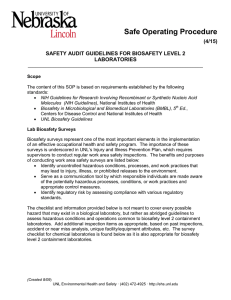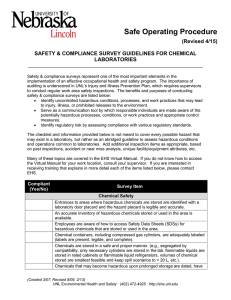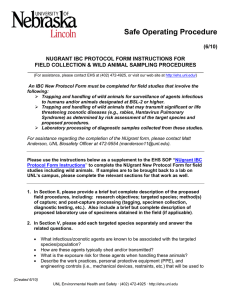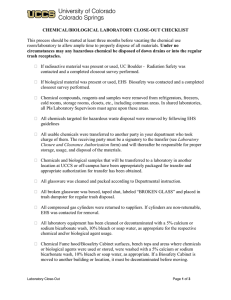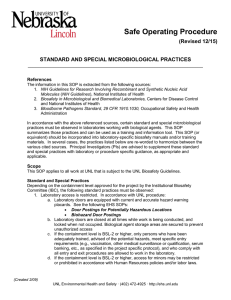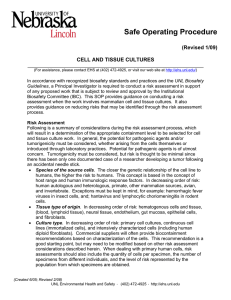Safe Operating Procedure (Revised 4/15) SAFETY AUDIT GUIDELINES FOR BIOSAFETY LEVEL 1 LABORATORIES
advertisement
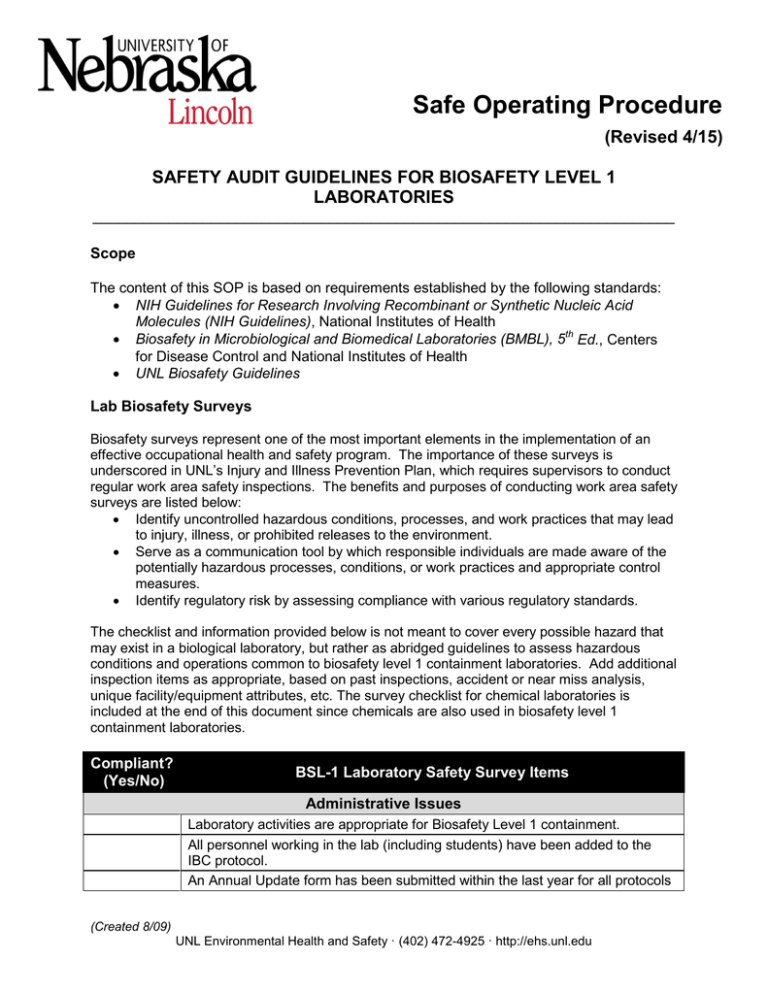
Safe Operating Procedure (Revised 4/15) SAFETY AUDIT GUIDELINES FOR BIOSAFETY LEVEL 1 LABORATORIES _____________________________________________________________________ Scope The content of this SOP is based on requirements established by the following standards: • NIH Guidelines for Research Involving Recombinant or Synthetic Nucleic Acid Molecules (NIH Guidelines), National Institutes of Health • Biosafety in Microbiological and Biomedical Laboratories (BMBL), 5th Ed., Centers for Disease Control and National Institutes of Health • UNL Biosafety Guidelines Lab Biosafety Surveys Biosafety surveys represent one of the most important elements in the implementation of an effective occupational health and safety program. The importance of these surveys is underscored in UNL’s Injury and Illness Prevention Plan, which requires supervisors to conduct regular work area safety inspections. The benefits and purposes of conducting work area safety surveys are listed below: • Identify uncontrolled hazardous conditions, processes, and work practices that may lead to injury, illness, or prohibited releases to the environment. • Serve as a communication tool by which responsible individuals are made aware of the potentially hazardous processes, conditions, or work practices and appropriate control measures. • Identify regulatory risk by assessing compliance with various regulatory standards. The checklist and information provided below is not meant to cover every possible hazard that may exist in a biological laboratory, but rather as abridged guidelines to assess hazardous conditions and operations common to biosafety level 1 containment laboratories. Add additional inspection items as appropriate, based on past inspections, accident or near miss analysis, unique facility/equipment attributes, etc. The survey checklist for chemical laboratories is included at the end of this document since chemicals are also used in biosafety level 1 containment laboratories. Compliant? (Yes/No) BSL-1 Laboratory Safety Survey Items Administrative Issues Laboratory activities are appropriate for Biosafety Level 1 containment. All personnel working in the lab (including students) have been added to the IBC protocol. An Annual Update form has been submitted within the last year for all protocols (Created 8/09) UNL Environmental Health and Safety · (402) 472-4925 · http://ehs.unl.edu Compliant? (Yes/No) BSL-1 Laboratory Safety Survey Items registered with the IBC. A biosafety manual has been prepared for the laboratory and is current. The Table of Contents form has been completed. All injuries/exposures involving biological agents in the lab have been reported to EHS and appropriate follow-up actions implemented. All workers have completed and are current with initial, annual refresher and/or supplemental training. Pathogen (animal, plant, or human pathogenic microbes and biological toxins) inventory is accurate and has been submitted to EHS. Standard Practices & Procedures The lab supervisor controls access to the laboratory. Hand washing is performed after working with potentially hazardous materials and before leaving the lab. Mouth pipetting is not practiced in the lab. Contaminated sharps are properly managed (contained in rigid, leak-proof, labeled container) and decontaminated prior to disposal. Procedures are conducted to minimize creation of splashes and/or aerosols. Work surfaces are decontaminated after completion of work and when spills or splashes occur. All cultures, stocks and other potentially infectious materials are properly decontaminated prior to disposal. (Including recombinant or synthetic nucleic acid-containing materials and organisms). Materials decontaminated outside of the lab are transported in a durable, leak proof and closed container. An effective pest management program is in place. A biohazardous spill kit is available in the lab and is appropriately stocked. Personal Protective Equipment Proper PPE is provided and in use in the laboratory. Gloves and other disposable PPE are changed when contaminated. Contaminated PPE is disposed of properly and is properly decontaminated if reusable. Laboratory Facilities & Equipment The lab has proper access control (e.g., doors that close and lock, etc.). Hand washing sink is available in the lab. Lab is designed for easy cleaning (e.g., rugs and carpet not present). Spaces between benches, cabinets, and equipment are accessible for cleaning. Chairs used in the lab are covered with a non-porous material that can be easily cleaned and decontaminated. Lab windows that open to the exterior are fitted with screens. Autoclave is working properly, is operated correctly and is tested with a (Created 8/09) UNL Environmental Health and Safety · (402) 472-4925 · http://ehs.unl.edu Compliant? (Yes/No) BSL-1 Laboratory Safety Survey Items biological indicator at an appropriate interval. Biosafety cabinet or other physical containment devices are properly maintained (i.e., cleaned and certified) and are used in a manner that ensures proper operation (e.g., not cluttered, correct sash height, etc.). Additional Items Compliant (Yes/No) Chemical Safety Survey Items Chemical Safety Entrances to areas where hazardous chemicals are stored are identified with a laboratory door placard and the hazard placard is legible and accurate. An accurate inventory of hazardous chemicals stored or used in the area is available. Employees are aware of how to access Safety Data Sheets (SDSs) for hazardous chemicals that are stored or used in the area. Chemical containers, including compressed gas cylinders, are adequately labeled (labels are present, legible, and complete). Chemicals are stored in a safe and proper manner. (e.g., segregated by compatibility, only necessary cylinders are stored in the lab, flammable liquids are stored in rated cabinets or flammable liquid refrigerators, volumes of chemicals stored are smallest feasible and keep spill scenarios to < 20 L, etc.). Chemicals that may become hazardous upon prolonged storage are dated, have been tested at the appropriate interval, and have not been stored for an excessive period of time. Quantity of chemicals outside of storage cabinets is as little as feasible. There is no evidence of food/drink consumption in the areas where chemicals are used or stored. Fire extinguishers are present, of the appropriate class, accessible, fully charged, mounted in their intended cabinet or bracket, and have been inspected within the last year. Emergency shower and/or eyewash are immediately available, accessible, and operable in areas where chemicals are used that can have an adverse health effects. Eyewashes and showers have been tested regularly. (Weekly for eyewashes and at least yearly for showers.) Adequate and appropriate chemical spill supplies are readily available. (Created 8/09) UNL Environmental Health and Safety · (402) 472-4925 · http://ehs.unl.edu Compliant (Yes/No) Chemical Safety Survey Items General Electrical Safety Power strips and extension cords are plugged directly into a permanently installed electrical outlet. Extension cords are restricted to temporary use. Multi-plug adapters are not used. Electrical cords are protected from damage and/or are in good repair. Unused openings in electrical cabinets, boxes, and fittings are closed with appropriate covers, plugs, or plates. Equipment and/or outlets are enclosed to protect against shock or electrocution. Ground Fault Circuit Interrupters (GFCI) are installed on outlets/circuits in damp/wet locations. Outlets in damp/wet locations are protected by water-tight housings. Power strips are UL or FM approved, and used solely for low power applications. Electrical equipment (includes appliances) are UL or FM approved and have not been altered in a manner that compromises the UL or FM approval. Three feet of clearance is maintained in front of electrical panels or breaker boxes; emergency shut-off controls to equipment are not blocked/inaccessible. Compressed Gas Cylinders Toxic, corrosive or pyrophoric gases are used/stored in a fume hood or gas cabinet. Compressed gas cylinders are properly restrained. Tubing, regulators, and other ancillary compressed gas cylinder equipment are in good condition and appropriate for the intended use. Valve caps are replaced when cylinders are not immediately in use. Fume Hoods Fume hood certification is current (< 1 year); and certification sticker is present and legible. Fume hood is being used in a manner consistent with its design (e.g., not cluttered); has not been compromised (e.g., structural components removed, holes drilled in the structure, etc.). Heated perchloric acid operations are restricted to a wash-down hood designed for this operation. Fume hood is not used for chemical storage (other than items requiring a ventilated enclosure). Fume hood sash is closed except when immediately working at the hood and then the sash is closed at least to the indicated working height to provide worker protection and containment. Hazardous Waste Management Waste containers are appropriately labeled (chemical name and indication that the material is no longer useable for its intended purpose). (Created 8/09) UNL Environmental Health and Safety · (402) 472-4925 · http://ehs.unl.edu Compliant (Yes/No) Chemical Safety Survey Items Collection containers are in good condition and compatible with the contents. Collection containers are securely closed when not immediately being filled. Volumes of waste in storage does not exceed satellite accumulation limits (55 gallon or one quart of P-listed) and are stored in the same area where generated. Chemical waste is disposed via EHS unless it has been approved for disposal via the sanitary sewer (See EHS SOP, Sewer Disposal List). Abandoned chemicals are not present (e.g., unlabeled, unknown, unwanted, unneeded, etc.). Solder and Solder contaminated materials are properly collected and tagged for pick up by EHS. Spill residues/materials, contaminated wipers/rags, bench papers or PPE are properly collected and tagged for pick up by EHS. Radioactive wastes are stored in a container identified with the name of the isotope, the radiation trefoil symbol, and the words "Caution Radioactive Material." PPE Personal protective equipment is available, accessible, consistently used by employees, appropriate for the operation(s) conducted, correctly sized and properly maintained. Standard attire (clothing and/or footwear) is appropriate for the lab (e.g., covers the torso and legs, close-toed shoes, non-melting fabric if there is potential for fire, etc.). Respirators are used only by persons currently enrolled in EHS’s Respiratory Protection Program. Laboratory and Engineering Controls Sharps are properly managed (e.g., stored in a rigid, leak-proof, labeled container to prevent accidental contact/injury). General housekeeping is observed in the lab. Means of egress (e.g., stairwells, exit doors, and common paths leading thereto) are maintained free of all obstructions or impediments to full instant use in case of fire or other emergency; and are not used for storage of combustible materials. 18" of clearance is maintained in all directions from sprinkler heads. 24" of clearance is maintained from the ceiling in non-sprinkled spaces. Fire alarm pull stations and fire strobes are unobstructed. Furnishings and equipment is stable, designed for the intended load, and used/secured in a manner to prevent injury. Engineering controls are available, appropriate, effective, and consistently used. The integrity of all building systems (e.g., electrical, HVAC, plumbing) are intact and not compromised. Machines and equipment have sufficient and/or proper guarding to prevent injury. (Created 8/09) UNL Environmental Health and Safety · (402) 472-4925 · http://ehs.unl.edu Compliant (Yes/No) Chemical Safety Survey Items Administrative and Other Safety Concerns Room is authorized for current use of registered/licensed material. All persons have completed appropriate safety training. Written safety procedures are available and complete (e.g., Virtual Manual/Chemical Hygiene Plan and lab-specific written protocols as appropriate/applicable) and employees know how and where to access plans and protocols. Additional Items (Created 8/09) UNL Environmental Health and Safety · (402) 472-4925 · http://ehs.unl.edu
